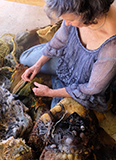

| Fiberworks | Individual Artists | Ethos & History | Membership | Galleries | Contact Us |
|
Title: Intertextures Materials: Exhibition: Major Minors I
|
| Please click on the image to view a larger version * Price excludes post and packaging. |
|
Title: Love Potion 25cm x 25cm Materials: Mixed textiles and embroidery threads. Exhibition: Major Minors II
|
| Please click on the image to view a larger version * Price excludes post and packaging. |
|
Title: Disavowal Materials: Poly-urethane, Velvet, Suedette, Fake-fur, Latex Exhibition: Fibreworks IV
|
| Please click on the image to view a larger version * Price excludes post and packaging. |
|
Title: Liminal Rite Materials: Hand dyed and commercial organic and synthetic fabrics and yarns. Hand and machine embroidery. Exhibition: "Fibreworks TEN Creative intersections, curated by Dr Elbe Coetzee, Mokgalakwena Gallery, Cape Town. Photo credits: Niklas Zimmer.
|
| Please click on the image to view a larger version * Price excludes post and packaging. |
|
Title: Re-Rooting Materials: Cement bag, chiffon, denim and lace, hand dyed yarn. Machine embroidered. Exhibition: Fiberworks 2019 Major Minors at the KZNSA Gallery in Durban, South Africa
|
| Please click on the image to view a larger version * Price excludes post and packaging. |
|
Title: Beyond an inferno Materials: Painted silk, chiffon, tulle and cotton. Hand spun, hand dyed and commercial yarns and embroidery threads. hand and machine embroidered. Hand quilted. Exhibition: Work in Progress
|
| Please click on the image to view a larger version * Price excludes post and packaging. |
|
Title: Beyond the inferno's edge Materials: Hand dyed, hand spun and commercial wool and yarns. Burnt door-frame wood and steel latch. Exhibition: Fibreworks 2019, NSA Gallery, Durban, South Africa. Resilience, 2019, Ponte d' Arte Gallery, Portugal.
|
| Please click on the image to view a larger version * Price excludes post and packaging. |
|
Title: Muti Bag Materials: Handcrafted felt, variety of yarns, lace, wool, beads, fabrics and found snake skin Exhibition: Fibreworks VIII in 2013 at the Emperor's Palace in Johannesburg
|
| Please click on the image to view a larger version * Price excludes post and packaging. |
|
Title: Aquatic Insurrection suspended aquatic creatures (W 36cm x H 18 x L 18cm - H 40cm x L 250cm x W 150cm), a dying "seabed" and mutated marine plants. Materials: Hand-made felt, hand-woven mohair, hand-dyed and commercial textiles, knitted wools and yarns, post-consumer waste. Hand and machine quilted and embroidered. Creatures - Resin castings and stainless steel. Exhibition: Tatham Art Gallery, Pietermaritzburg. Oliewenhuis Art Museum, Bloemfontein - Terra Exhibition curated by Prof. Elfriede Dreyer Photo credit: Carla Crafford
|
| Please click on the image to view a larger version * Price excludes post and packaging. |
|
Title: Aquatic Insurrection (Details) suspended aquatic creatures (W 36cm x H 18 x L 18cm - H 40cm x L 250cm x W 150cm), a dying "seabed" and mutated marine plants. Materials: Hand-made felt, hand-woven mohair, hand-dyed and commercial textiles, knitted wools and yarns, post-consumer waste. Hand and machine quilted and embroidered. Creatures - Resin castings and stainless steel. Exhibition: Tatham Art Gallery, Pietermaritzburg. Oliewenhuis Art Museum, Bloemfontein - Terra Exhibition curated by Prof. Elfriede Dreyer Photo credit: Carla Crafford
|
| Please click on the image to view a larger version * Price excludes post and packaging. |
|
Title: Litany Materials: Hand dyed commercial, organic and synthetic textiles and yarns, rusted 19th Century pressed ceilings, wire and PET plastic. Techniques: Hand weaving, hand knitting, sculpted felting, sculpted plastics. Hand and machine embroidery, machine quilting. The academic sources consulted are available on request. Exhibition: Mokgalakwena Gallery, Cape Town curated by Prof. Elbe Cotzee Photo credit: Niklas Zimmmer
|
| Please click on the image to view a larger version * Price excludes post and packaging. |
|
Title: Litany Pod Details Materials: Hand dyed commercial, organic and synthetic textiles and yarns, rusted 19th Century pressed ceilings, wire and PET plastic. Techniques: Hand weaving, hand knitting, sculpted felting, sculpted plastics. Hand and machine embroidery, machine quilting. The academic sources consulted are available on request. Exhibition: Mokgalakwena Gallery, Cape Town curated by Prof. Elbe Cotzee Photo credit: Niklas Zimmmer
|
| Please click on the image to view a larger version * Price excludes post and packaging. |
Celia de Villiers |
 |
